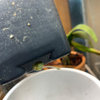Ziplock Rooting Method
grownsk
12 years ago
Related Stories

GARDENING GUIDESThe Beauty of Bare-Root Plants
Plant dormant trees and shrubs in fall using the easy, affordable bare-root method and enjoy beautiful results in spring
Full Story
MODERN ARCHITECTURERoots of Style: International Style Celebrates Pure Form
Using technology and materials of the time, International style is always current. See its expression in these 16 homes around the world
Full Story
ARTThe Beauty of Bonsai — Living Art, Rooted in Harmony
Create your own emblem of nature's balance with an art form dating back 1,000 years
Full Story
ARCHITECTURERoots of Style: Where Did Your House Get Its Look?
Explore the role of architectural fashions in current designs through 5 home styles that bridge past and present
Full Story
ROOTS OF STYLERoots of Style: The Birth of Modern Architecture
Learn how Prairie, Craftsman, art deco and other styles of the early 20th century came to influence architecture today
Full Story
TRADITIONAL ARCHITECTURERoots of Style: Château Architecture Strides Through a Century
Live like a lord with design details that recall French estates of old, even if they're scaled down and updated for today
Full Story
ARCHITECTURERoots of Style: Art Deco and Art Moderne
Get to know the similarities and differences between these architectural styles of the 1920s and 1930s
Full Story
ARCHITECTURERoots of Style: See What Defines a Craftsman Home
Charming features and intimate proportions have made Craftsman houses an American favorite. See their common details and variations
Full Story
ARCHITECTURERoots of Style: The Segmental Vault Home
Distinctive and proud, these houses may be more common than you might first realize
Full Story
GARDEN STYLESNew Garden Styles Reveal Roots in Arts and Crafts Design
Landscape design from a century ago is still influencing gardens today — see if any of its features have sprung up in yours
Full StoryMore Discussions







roseseek
grownskOriginal Author
Related Professionals
Ashburn Landscape Architects & Landscape Designers · Franconia Landscape Architects & Landscape Designers · Oconomowoc Landscape Architects & Landscape Designers · Saint Charles Landscape Architects & Landscape Designers · Waterbury Landscape Contractors · Maple Valley Landscape Contractors · Deerfield Landscape Contractors · Downey Landscape Contractors · Lemont Landscape Contractors · Mesa Landscape Contractors · Saint George Landscape Contractors · Walnut Creek Roofing & Gutters · Cincinnati Roofing & Gutters · Port Neches Roofing & Gutters · Wayne Roofing & Guttersroseseek
grownskOriginal Author
roseseek
SowNan
lala_e